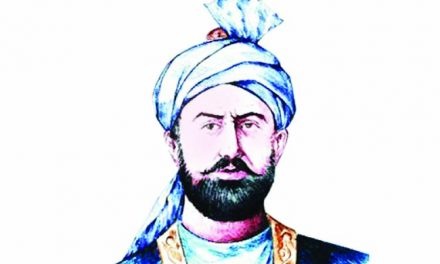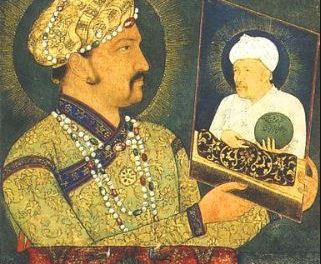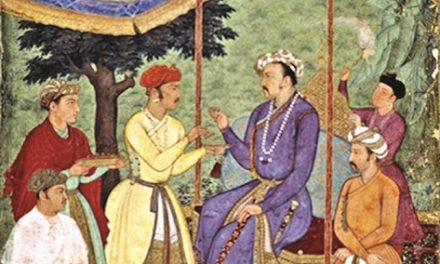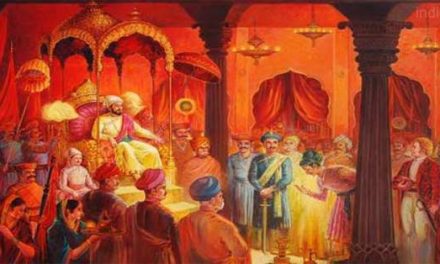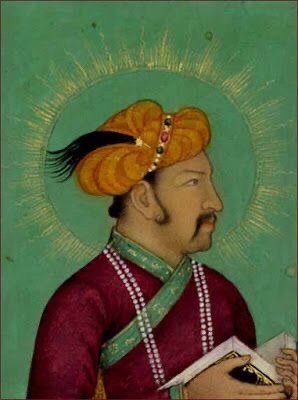
In the history of Mughals, one name that stands out among the rest is Emperor Akbar. He was the greatest of all the emperors to rule the Mughal Empire. We know about all his conquests, journeys and victories, but an integral part of his life is lesser-known to many. Despite having most of the Indian subcontinent under his grasp, his greatest sorrow till the age of 27 was the lack of an heir of his empire. In 1564, Akbar had twin sons, Hassan and Hussain, but both of them were only a guest in his life for a month. Years passed by, but the emperor remained childless. He became desperate for a son and prayed to Khwaja Moinuddin Chishti, making a promise that if he is blessed him with a son; he would walk from Agra to Ajmer and visit his dargah.
Soon after, he got the news that there was another Sufi saint named Sheikh Salim Chishti, who lived near Agra in Sikri, who could help him. Without further delay, Akbar went to ask him to pray for a male heir for the throne. Chishti blessed Akbar, assuring him he would not just have one, but three sons to take over his empire.
In 1569, Akbar heard the news that his first Hindu wife, Mariam-uz-Zamani, popularly known as Harka Bai, was expecting a child, as promised by Chishti. The expectant empress was sent to Sheikh’s humble dwelling Sikri during the latter period of her pregnancy so that she could be surrounded by the blessings of the holy man. This was also an ideal decision taken by Akbar to avoid unnecessary gossip around the court regarding his personal life.
One day, during the pregnancy, the baby stopped kicking. A strange numbness dawned on her when she realised the possible outcomes of this situation. She could not speak and only wished for everything to go back to normal. Upon hearing the news, Akbar thought to himself that, perhaps to gaon something he truly loves, he was meant to give something up. He had already promised a pilgrimage to Ajmer and moved his wife under the protection of blessings. This could possibly be his final test. Akbar then decided to sacrifice one of his favourite hobbies for the wellbeing of his child. The emperor, like most royals, loved to hunt; especially the spectacular sport of hunting with cheetahs. Since this was a time for a new life, he vowed that never again would he hunt with cheetahs if only his baby would move again. And never again he did.
On 30 August 1569, the first heir of Akbar’s throne was born and received the name Nur-ud-din Muhammad Salim, in acknowledgement of his father’s faith in the efficacy of the holy saint’s prayer. His imperial name, which he came to be known as later in life, was Jahangir, which means ‘conqueror of the world’.
At the birth of Prince Salim, great festivities took place at Agra. The emperor ordered all captives, except political ones, to be freed. Seven days of continuous celebrations were arranged in Agra. According to the custom, the baby born was handed over to a senior Mughal favourite courtier ‘s wife, who had recently had a baby. Prince Salim’s milk mother was Chishti’s daughter and her son Qutubuddin Koka was his milk brother. The family enjoyed this prestigious position all their life.
Prince Salim was a naughty child and the womenfolk in harem pampered him with affection. His grandmother Hamida Banu and his stepmothers Ruqaiah Sultan and Salima Sultan were very fond of him as well. He was very close to his father’s chief consort, Salima Begum, and his stepmother, Jodhpur Princess Maharani Rukmavathi, whose niece, Jodha Bai, he later married.
Growing up prince Salim lived a very luxurious life. Unlike himself, Akbar ensured his son had the best teachers of the kingdom. Mir Kalan Harvi was Prince Salim’s first tutor and raised Prince Salim on his shoulders. Akbar then selected a religious scholar called Shaikh Ahmed and assigned him as his mentor. In 1579, Akbar appointed Qutubuddin Khan, a high-ranking noble and the uncle of the milk brother of Emperor Akbar, Mirza Aziz Koka, as the teacher of Prince Salim. Later Abdul Rahim Khan I Khanan, a poet and one of the nine important ministers of the court, also known as Navratnas, was appointed as the prince’s mentor.
Prince Salim received the best education. He studied different languages like Urdu, Persian, Turkish, Arabic and, Hindi. He learned to compose poems from Abdul Rahim. French and Portuguese taught him about science and medicine etc. Much like his grandfather Emperor Humayun, Prince Salim had a great interest in astronomy, science and nature. Jahangir wanted to build an observatory in Agra near the Jamuna river but could not fulfil his vision due to struggles later in his life.
Although Prince Salim started war training at the young age of 8 or 9, his education never stopped. Tutors accompanied him on the fields of war, and he continued his studies. Salim was very passionate about science and loved animal experimentation and bird and plant observations. Jahangir even wrote elephant gestation period accurately as 18 months before he was proven correct by the scientists in the 20th century.
Prince Salim ‘s appreciation of nature and wildlife was remarkable, even though he enjoyed hunting. In the freezing winter, while his elephants shivered to bathe in the Yamuna River, Emperor Jahangir ordered his swimming pool to be lined with hot water, so that his elephants could bathe in hot water. He liked to have the elephants, the tiger and the cheetah as his children. His beloved animals would often accompany him during his strolls in the garden. He designed Hathi Mahal for the retired elephants of his royal force and constructed Hiran Minar memorial tomb for his pet deer Manas Raj in the village of Sheikhupura in the outskirts of Lahore. Scientists loved his Jahangirnama for its observations on animals and birds and used that information in biology, botany, zoology, geography and several other fields. The prince was a naturalist of the highest order.
Everybody knows Prince Salim as emperor Jahangir, who enjoyed alcohol and opium and did not live up to his father’s standards. But there are a lot of wonderful traits about the man that we fail to acknowledge.
Prince Salim went to the war field at a very young age. In 1581 he was in charge of the Kabul campaign when he was only 12 years old and had 5000 soldiers under him. By 1585 he had 12000 soldiers, the highest any military commander could have, except the emperor, when he was only 16 years old. As a young prince, Salim was no different from his predecessors; he decided to gain care of the throne when his father was still in power. History informs us that it was typical for any heir to attempt, more or less actively, to overthrow his father. When he was 22 years old, he left for Allabahad and rebelled against his father, turning his troops against him. However, his efforts were futile. He revolted again, 10 years later, but was unsuccessful for the second time. A little while after that, in 1602, he proclaimed to be the emperor and had a coin made, which was a symbol of independence in the kingdom. Besides the constant revolts, he also assassinated Akbar’s secretary.
During this time, their father-son relationship took a hit and Akbar got his son arrested. Their personalities clashed with one another at some point, and Akbar had then decided to give the throne to his grandson, Prince Khurram, after him. But Prince Salim and Akbar patched things up soon enough and before his death, in 1605, Akbar named his son as the new Emperor of the kingdom. Upon becoming the new emperor, Prince Salim chose the Persian name, Jahangir.
Jahangir remains a man with conquests throughout history. Jahangir sent Mughal general Shaikh Alauddin Chishti to subdue Musa Khan, the Bara-Bhuiyan leader in Bengal, in 1608. He opened many fronts, including that of Mewar, a province in the south of the Empire whose governor, Amar Singh, ended up surrendering to Prince Khurram in 1613. There were also two other fronts in the North, one of which concerns the fight against the Kangra Raja, the other against the Ahoms, which caused more problems for the Mughals than most other people. The Deccan was also the target of the conquerors. The Deccan is in the central part of India, rather to the south. It is a massive plateau whose inhabitants came to Jahangir in 1615.
Jahangir also dreamed of capturing the fort of Kangra, which Akbar had sought to accomplish in 1615. As a result, a siege was laid and the fort was captured in 1620, which resulted in the surrender of the Raja of Chamba, the strongest of all the Rajas in the area. The district of Kistwar, in the state of Kashmir, was also conquered under Jahangir’s reign
During his rule, Jahangir dealt with international invaders as well. The Europeans wanted to set up trade with the Indian subcontinent, as a gateway to Asia. When the Portuguese clashed with the Mughals in 1613, they could not survive. The emperor learned that the Portuguese had constructed illegal fortifications and ‘dwellings of the greatest splendour and power’ in Hughli, Bengal, as well as flouting the laws of Mughal by rendering compulsory conversions to Christianity, and ordered the Portuguese settlements to be destroyed and the foreign expelled Later, the British also surrendered seeing how strong the Mughals were despite wanting to make a permanent trade agreement. Thomas Roe was the British ambassador who was sent to obtain permission for the British East India Company’s factory in Agra. He also became close to Jahangir while staying at his court but could not get approval for the factory.
Thomas Roe’s journal gave us an insight into Jahangir’s life as well. Jahangir, like his father, was not an orthodox Sunni Muslim, but Roe labelled him as an atheist. Despite the casual usage of the term, he could put a finger on Jahangir’s beliefs and said that he had rules and religion of his own.
Jahangir was fascinated by art and was fond of music, painting and architecture. He preserved paintings from Emperor Akbar’s period. Jahangir protected artists and created a workshop in his capital that welcomed the ones that had his preference in art. Mughal art achieved a high degree of beauty and abundance throughout his reign. Jahangir’s era is associated with the development of monuments like Itimad-ud-daulah in 1622, where the use of white marble appeared to indicate a new age of architecture in the Mughal Empire. The architecture resulted in the style of Taj Mahal, built by his son Shah Jahan.
Jahangir travelled very often and improved certain roads along his way. Alongside the paths of Gujrat, he created platforms for traders to rest their heavy bags in since the route was frequently used by them. His observant nature was yet again evident through these small gestures. Jahangir was an extremely sensitive, curious and intelligent man: an observer of surroundings and a passionate collector of his fascinations, from Venetian swords and globes to Safavid silks, jade pebbles and even narwhal teeth.
The Emperor’s personal life is somewhat linked to his political life. Just like every other Mughal ruler, he had several wives but the one he truly loved and held close to his heart was his chief consort, Nur Jahan. Nur Jahan, born as Mehr-un-Nisa, is one of the better known Mughal women who was acknowledged for her intelligence and grace. She was widowed at a young age when her husband, Ali Quli Istajlu, who was transferred to Burdwan, in Bengal, by Jahangir, was killed in a fracas with Qutbuddin Khan, the Governor of Bengal. Later, she was brought to Agra along with her daughter Ladlii and was made an attendant to Salima Sultana Begum, Akbar’s wife, and Jahangir’s stepmother.
In 1611, Jahangir fell in love with her when he met her at Meena Bazar – a new year fair started by Akbar in which the emperor was the only male present while noblewomen, princesses and other female members of the royal harem exhibited brocades, exquisite silks, fine muslins, bejewelled turbans and the like. He proposed immediately and got married later that year. Mehr-un-Nisa, being Jahangir’s 18th and last wife, was given the title of Nur Mahal or Light of the Palace and later Nur Jahan or Light of the World, by Jahangir. She was also given the title of Badshah Begum. When Jahangir fell sick, which was often, he gave Nur Jahan the permission to take over the government responsibilities while she monitored his health too.
Jahangir is generally thought to be a weak and incompetent king. Brought up with every luxury and comfort, Jahangir did not have to thrive as much as his forefathers. At a very young he grew a love for drinking and that had become a habit that was always criticized by many. Some also consider him a tyrant for he was hot-headed and took rash decisions when it came to wrongdoers. However, Jahangir was also a generous man who forgave the ones who protested against him.
Most of his character and lifestyle was heavily influenced by negative propaganda, mainly by his Shahjahan and the English ambassador Thomas Roe. It is a shame that he was thoroughly compared to his father and later his own son. His reign was not meant to matched with others, rather embraced and appreciated. Every ruler has flaws and drawbacks but they also have qualities that make them unique.
Out of the six Mughal Emperors, Jahangir is mentioned as one who does not stand out from the rest. He is addressed as a heavy drinker and opium addict, which cannot be denied but should not stain his entire life. He might not have been a military man but he appreciated the greatest creations of nature.
Before his death, he frequently visited Kashmir and Kabul to restore his health by basking in the beauty of nature. However, it did not help much as he had to return to Kabul due to the extreme weather conditions and died on his journey back. The body was then transported by the palanquin to Lahore and laid to rest in Shahdara Bagh, a suburb of that city. Today, the exquisite mausoleum is a popular tourist attraction destination.
https://dailyasianage.com/news/232569/jahangir–the-curious-and-observant-mughal-emperor?fbclid=IwAR0qj5WWjw-eE-EFdFqX4yzT6s8idNzdIXNdAzeYvRCyC8iwa0WdNXHGNGM

